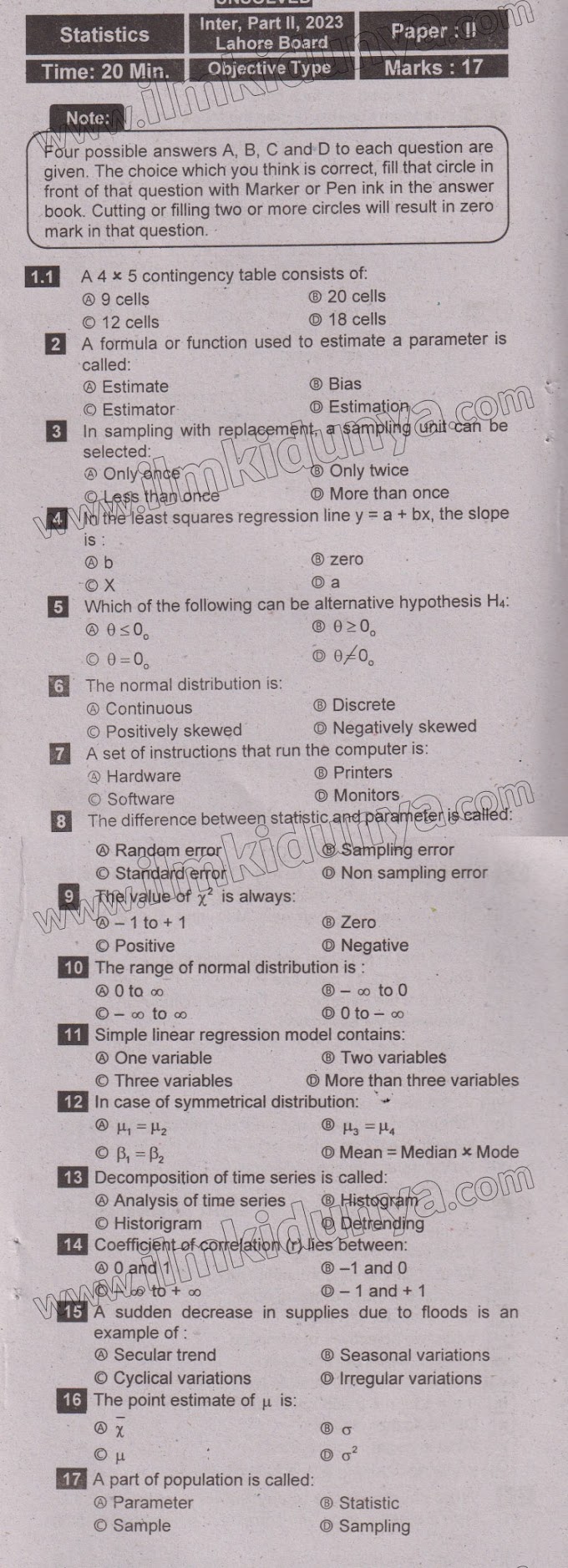Here you will see important short questions and important definitions of chapter 12 Estimation.
Only request is to subscribe to this channel on youtube Welcome Academy for more videos about your paper.
12th class statistics chapter 12,Estimation,important definitions and short questions,2nd year class statistics
If you have any questions please leave a comment here,I will be very thankful to see your question.
#12thcalssstatistics #chapter12 #Estimation #shortquestions #definitionitons @12thcalssstatistics @chapter12 @Estimation @shortquestions @definitionitons
#welcomeacademyChapter 12: Estimation
These are very important question according to paper pattern.
Q.1 What is meant by statistical inference?
Ans: It is the conclusion made about the unknown value of the parameter of the
population using information contained in an observed sample taken from
population at random.
Q.2 Define estimation.
Ans: The statistical estimation is a procedure of making judgment about the unknown
value of a population parameter by using sample observation.
Q.3 Differentiate between estimator and estimate.
Ans: Estimator is the rule or method that used to estimate a parameter, whereas an estimate is the numerical value obtained by sample data.
Q.4 Explain estimator and estimate by example.
Q.5 What are the different types of estimation?
Ans: Two types of estimation are: (1) Point Estimation (2) Interval Estimation.
Q.6 Define point estimation.
Ans: The method of finding the single unknown value of parameter from the sample
values by using an estimator is called point estimation.
Q.7 Define point estimate.
Ans: A single numerical value calculated from sample data by using an estimator is
called point estimate.
Q.8 Define Interval estimation.
Ans: The method of finding an interval, on the belief that it will include the parameter
θ with a known probability is called interval estimation.
Q.9 Define interval estimate.
Ans: An interval, calculated on the belief that it will include the parameter θ with a known probability is called interval estimate.
Q.10 What is meant by interval?
Ans: The range of values is called interval. Example [a,b].
Q.11 What is meant by confidence interval?
Ans: An interval to which 100(1-α)% probability is associated that it will include the
parameter is called confidence interval. Example P(L< θ < U) = 1 -α
Q.12 What is confidence coefficient?
Ans: 1 -α or 100(1-α )% probability associated with an interval that it will contain the
parameter is called confidence coefficient. Confidence coefficient is also called
level of confidence.
Q.13 Estimator is a statistic, explain?
Ans: Estimator is sample statistic used to estimate true value of population parameter, hence it is always statistic which is both function and random variable with probability function.
Q.14 What are the properties of good point estimator?
Ans: Properties of good point estimator are:
(1) unbiased ness (2) efficiency ( 3) consistency (4) sufficiency
Q.15 Explain unbiasedness.
Ans: An estimator is defined to be unbiased when an estimator has its expected value
equal to the true value of population parameter.
Suppose θ be an estimator and θ is a parameter then,
E(θ) = θ , then θ is an unbiased estimator of θ
E(θ) ≠ θ , then θ is a biased estimator of θ
E(θ)> θ , then θ is a Positive biased estimator of θ
E(θ)< θ , then θ is a Negative biased estimator of θ
Q.16 Write the formula of bias.
Ans: Bias = E(θ ) - θ
Q.17 Is an estimator a random variable?
Ans: An estimator is a random variable having its own probability distribution.
Q.18 Why interval estimation is useful?
Ans: Interval estimation is useful, because interval estimation provide precision of the
estimate.
Q.19 What are advantages of interval estimation?
Ans: ★ It provides an interval of values that is lively to include the unknown true value of the parameter.
★Interval estimation provides precision of the estimate.
Q.20 Describe methods for increasing precision.
Ans: ☆ By decreasing standard error to estimate.
☆ By decreasing the confidence coefficient.
Q.21 Define lower and upper confidence limits.
Ans: The end point “L” and “U” that bound the confidence interval are called lower and upper confidence limit for parameter θ . Example P(L< θ < U) = 1-α .
Q.22 What is the effect on confidence interval for μ, if “n” decreases?
Ans: The length of confidence interval for “ μ ” increases by “n” decreasing.
Q.23 When finite population correction factor can be ignored for estimating μ ?
Ans: The finite population correction factor can be ignored when sample size “n” is less than 5% of population size “N”.
Q.24 What are large sample and small sample?
Ans: When n ≥30 samples is called large size otherwise small sample.
Q.25 Define t – statistic.
Ans: Let a small sample of size n<30 is drawn from a normal population with unknownvariance, then the sampling distribution of the statistic with "v" d.f .
Q.26 Describe the term degree of freedom.
Ans: Degree of freedom represents the number of independent random variable that
expresses the sampling distribution.
Q.27 How the width of confidence interval can be decreased?
Ans: The width of confidence interval can be decreased by:
(i) Increasing the sample size.
(ii) Decreasing confidence coefficient (level of confident).
Q.28 What is the best estimator of population proportion?
Ans:
The best estimator of population proportion
Q.29 What is the pooled estimator of population mean and population proportion?
Ans:
The pooled estimator of population mean is
The pooled estimator of population proportion is
Q.30 Give pool estimator of population variance.
Ans:The pooled estimator of variance is











0 Comments
Thanks for message us We shall approve it if you have oxygen like words for us